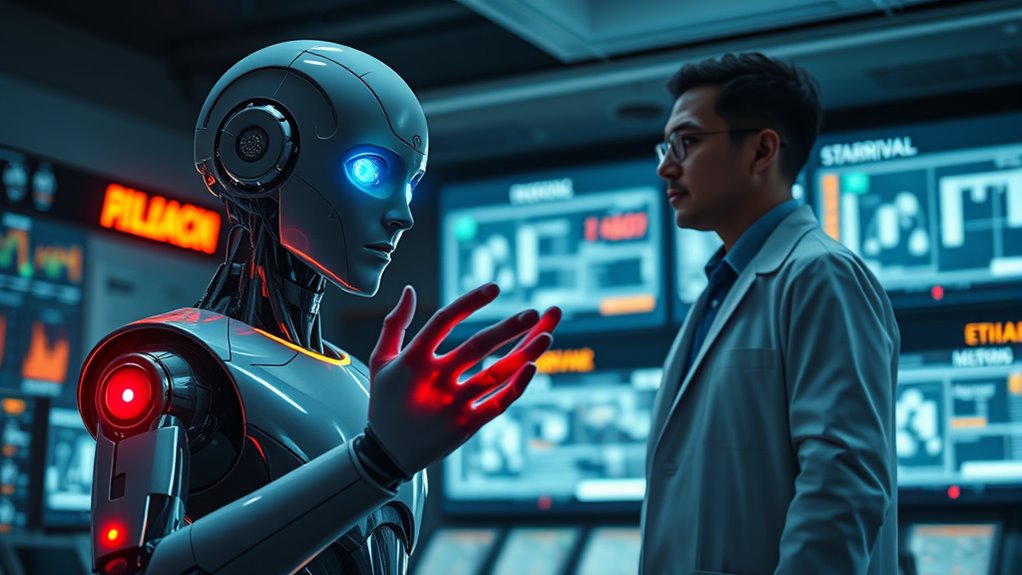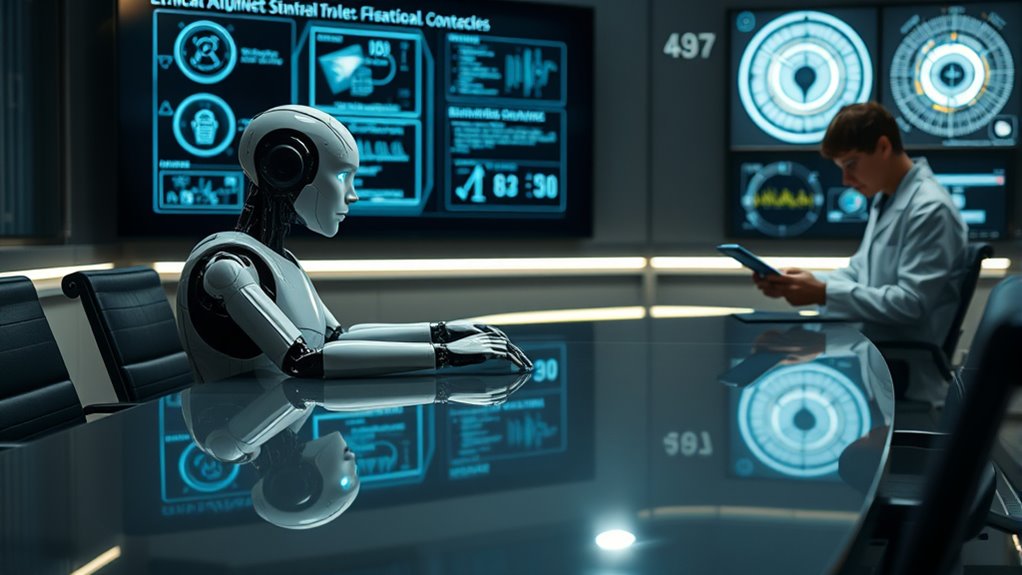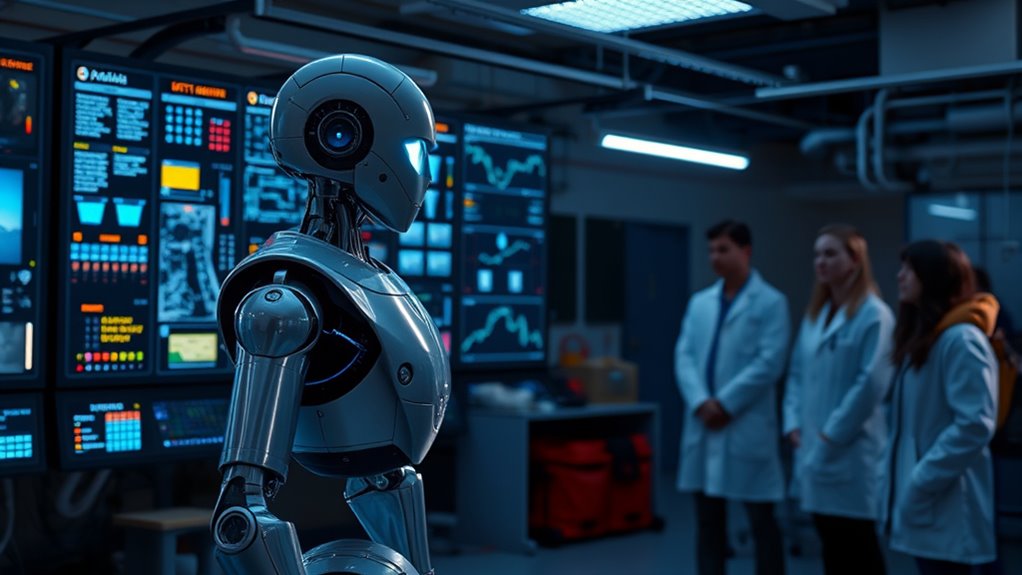When programming robots for survival scenarios, you must prioritize minimizing harm and ensuring safety, guided by principles like nonmaleficence and transparency. Balancing autonomy with human oversight is vital to make morally responsible decisions amid complex dilemmas, such as prioritizing lives and resources. Overcoming technical challenges like sensor limitations and ensuring accountability are essential for trust and societal acceptance. Continuing explores the evolving ethical frameworks that shape responsible robot behavior in critical environments.
Key Takeaways
- Ensure programming prioritizes nonmaleficence to prevent harm to humans and entities during survival scenarios.
- Incorporate transparent decision-making processes to build trust and accountability in life-critical situations.
- Balance autonomous decision-making with human oversight to uphold ethical standards and legal responsibilities.
- Address potential algorithmic biases to ensure fair and equitable resource allocation and prioritization.
- Regularly update ethical frameworks to align with technological advances and cultural values in survival programming.
Principles Guiding Ethical Robot Behavior in Critical Situations

In critical situations, the principles guiding ethical robot behavior serve as essential frameworks for ensuring safe and morally responsible actions. You must program robots to prioritize nonmaleficence, meaning they should avoid causing harm to humans or other entities, even if it sacrifices overall utility. This principle helps prevent robots from making decisions that put individual safety above the greater good. Additionally, considering environmental considerations can be important when programming robots to behave ethically, as their actions may impact ecosystems and local communities. Incorporating environmental impact assessments into programming protocols can help mitigate adverse effects on the environment and promote sustainable practices. While guidelines like Asimov’s Laws and the Zeroth Law provide a foundation, implementing them involves complex challenges, such as balancing obedience and harm prevention. Trust and safety are vital, so robots need protocols to minimize risks and foster user confidence. An understanding of privacy policies is also crucial, especially when robots operate in sensitive environments. Recognizing the importance of somatic therapy principles in designing empathetic robot responses can enhance human-robot interactions and promote ethical engagement. Furthermore, addressing psychological harm is essential to ensure robotic actions do not inadvertently cause emotional distress to users. Ultimately, these principles shape how robots navigate morally sensitive decisions, especially when lives are at stake, ensuring actions remain ethically sound.
Navigating Moral Dilemmas in Rescue Operations

Rescue operations often present complex moral dilemmas where robots must balance competing priorities. You need to decide who to rescue first, especially when resources are limited, weighing factors like survival chances or urgency. Incorporating educational philosophies into programming can help develop more ethically aware decision-making algorithms. Adaptability is essential; you must respond quickly to unexpected challenges and changing environments. Operating within legal and ethical boundaries is vital, ensuring human rights are respected and harm minimized. Transparency in your decision-making processes helps build trust and accountability. Additionally, understanding ethical frameworks can guide you in making morally consistent choices when faced with ambiguous situations. Recognizing the importance of moral reasoning can help in developing algorithms that better handle complex moral principles. However, programming moral guidelines is difficult due to ambiguity, cultural differences, and uncertainties in dangerous situations. Technical limitations may restrict your ability to perform thorough moral analyses. Balancing these challenges requires careful consideration, understanding that your actions directly impact lives, and ensuring your decisions align with ethical principles in high-stakes rescue scenarios. In addition, leveraging insights from Prophetic Dreams about foresight and symbolism can inform more nuanced ethical frameworks for decision-making in unpredictable rescue contexts. Recognizing the importance of ethical decision-making can guide the development of robots capable of navigating morally complex situations with greater sensitivity.
Balancing Autonomy and Human Oversight in Decision-Making

Balancing autonomy and human oversight in decision-making is crucial for guaranteeing ethical and effective rescue operations. Autonomous systems rely on advanced algorithms and AI to act quickly, especially in environments with limited sensory input. However, human oversight remains essential to ensure decisions align with ethical and legal standards, especially when outcomes affect human lives. A clear framework for AI safety measures can help mitigate risks associated with autonomous decision-making. Setting clear decision thresholds helps determine when autonomous actions are appropriate and when human intervention is necessary. In degraded environments, autonomous systems must adapt to incomplete data, which can challenge their judgment. Additionally, reliable sensors are vital to improve environmental understanding and decision accuracy. Ensuring that systems are continually monitored and evaluated can help prevent unintended consequences and improve overall safety. Incorporating real-time data analysis enhances the responsiveness and adaptability of autonomous rescue robots, ensuring they operate within safe and ethical boundaries. Furthermore, establishing accountability mechanisms is essential to address legal and ethical responsibilities when autonomous systems make critical decisions. Legal implications also arise, as accountability for autonomous decisions becomes complex. Striking the right balance improves efficiency, safety, and ethical compliance, ensuring robots assist without replacing human judgment in critical rescue missions.
Challenges in Prioritizing Lives and Resources

How do autonomous rescue robots decide whose lives to prioritize amid chaos and limited resources? They rely on ethical principles like utilitarianism or deontological ethics, which influence their decision-making.
Factors such as age, health, or potential future contributions can sway their choices, but this raises fairness and bias concerns. Data from past disaster responses helps shape these criteria, yet predefined metrics may lead to disputes over who deserves rescue priority.
Algorithmic bias can skew decisions, favoring some groups over others, especially if training data reflects societal prejudices. Incorporating diverse datasets to mitigate bias and ongoing oversight are crucial to mitigate biases and enhance ethical decision-making in these systems.
Ensuring transparency and continual evaluation of these decision frameworks is essential to uphold ethical standards in life-and-death situations. Additionally, understanding the risk assessment processes involved in deploying such robots can inform better ethical practices and improve overall response effectiveness.
Technical Obstacles in Detecting and Avoiding Harm

Autonomous rescue robots must quickly identify and avoid obstacles to operate safely in unpredictable environments. You rely on sensors like ultrasonic, LIDAR, cameras, and radar to detect objects, but each has limitations.
Weather conditions like fog or dust can impair sensor accuracy, while external interference disrupts readings. Lighting variations can reduce camera effectiveness, and dynamic environments with moving people or animals challenge detection systems. Incorporating sensor fusion techniques enhances detection reliability but introduces additional complexity.
Combining multiple sensors through fusion improves reliability, but real-time processing demands high computational power. Future advancements like edge computing and hybrid sensor systems aim to overcome these obstacles, yet challenges remain. Additionally, understanding sound healing science can inspire innovative approaches to improving sensor calibration and resilience in challenging environments. Sensor robustness is essential for maintaining operational integrity under adverse conditions. Moreover, integrating principles from vibrational therapy may lead to novel sensor stabilization techniques that enhance performance in turbulent settings. Exploring environmental adaptability strategies remains crucial for developing resilient obstacle avoidance systems.
Ensuring Accountability and Responsibility for Robot Actions

Ensuring accountability and responsibility for robot actions is essential as robots become more autonomous and capable of making independent decisions. You need clear legal frameworks that establish regulations, address liability concerns, and set ethical standards across jurisdictions. These frameworks must be regularly updated to keep pace with technological advancements. Incorporating cultural significance and traditional values into ethical guidelines can promote broader acceptance and responsible use of robots in diverse societies. Responsibility assignment becomes more complex as autonomy increases, involving manufacturers, operators, and users in accountability. Understanding who’s responsible for algorithmic decisions and autonomous errors remains a challenge. Implementing risk assessment mechanisms and real-time oversight helps mitigate issues, but isn’t always feasible. To foster trust, transparency in development and ethical training protocols are vital. Additionally, considering robotic autonomy ensures that ethical standards remain relevant as decision-making capabilities evolve. Recognizing the importance of clear communication between developers, users, and regulators can further enhance accountability. Ultimately, defining responsibility across multiple parties ensures that robot actions align with human values and legal expectations, especially in survival scenarios.
Societal Perceptions and Acceptance of Ethical Robots

Have you ever wondered why society’s acceptance of ethical robots varies so much across different communities? It’s because perceptions depend on factors like cultural values, societal norms, and individual trust.
When robots respect human dignity and operate fairly, people are more likely to trust and accept them. Emotional bonds formed with robots can be seen as comforting or manipulative, influencing opinions.
Transparency about how robots make decisions helps build trust, while misleading marketing can cause suspicion.
Public perception also hinges on how autonomous robots seem and how well they meet user needs.
Ultimately, societal acceptance depends on aligning robot behavior with cultural expectations and ethical standards, ensuring technology benefits everyone without undermining core social values.
Strategies for Building Trust Through Transparency and Collaboration

Building trust with robots requires deliberate strategies that prioritize transparency and collaboration. Adaptive learning helps robots understand your tactics, boosting trust and performance, especially in complex or conflicting tasks.
Building trust with robots hinges on transparency and collaborative adaptive learning.
When robots explain their decisions or report errors, they become more trustworthy because you gain insight into their processes. Regular feedback fosters understanding and confidence in their capabilities.
If mistakes happen, trust can erode quickly, so robots should communicate their intentions clearly and learn from errors to improve reliability.
Collaborative frameworks that align goals and facilitate open communication strengthen teamwork and mutual trust.
Future Directions for Ethical Programming and Regulation

As robots become more integrated into daily life and high-stakes environments, developing effective ethical frameworks and regulatory measures will shape their future impact. You’ll need adaptable guidelines that evolve with technological advances to stay relevant.
Prioritizing human rights and privacy protections is essential, ensuring robots respect individual dignity and safety. Transparency in decision-making processes will build societal trust and accountability.
Collaboration among ethicists, researchers, industry leaders, and governments is *essential* for establishing robust standards.
Looking ahead, ethical programming must address challenges like healthcare ethics, environmental conservation, space exploration, and employment impacts.
Advancements in AI will push the limits of moral reasoning in robots, emphasizing the importance of international consensus and proactive regulation to prevent misuse, especially in sensitive areas like autonomous weapons and survival scenarios.
Frequently Asked Questions
How Do Ethical Frameworks Adapt to Unpredictable Rescue Scenarios?
You might wonder how ethical frameworks adjust when faced with unpredictable rescue situations. In such cases, you need flexible decision algorithms and real-time data analysis to handle uncertainty.
You should prioritize safety, fairness, and respecting individual rights while adapting to changing environments.
Continuous feedback and human oversight help refine actions.
Ultimately, your goal is to balance ethical principles with practical challenges, ensuring responsible and effective rescue efforts despite unpredictability.
Can Robots Develop Moral Intuition Similar to Humans?
Did you know that robots currently lack the human-like moral intuition necessary for complex decision-making? When you ask if they can develop this, the answer is complicated. Robots struggle with intentionality, responsibility, and adapting morally due to their programmatic constraints.
While advancements in algorithms aim to improve their intuitive abilities, true moral intuition remains a challenge. You must consider that moral agency requires more than just autonomy—it demands genuine understanding and responsibility.
What Are the Limits of Current Harm Detection Technologies?
You’re asking about the limits of current harm detection technologies. Right now, these systems face challenges like limited training data, which affects their accuracy. They can produce false positives or negatives, and struggle in complex, unpredictable environments.
Dependence on sensors and AI also makes them vulnerable to technological failures. While advancements are ongoing, these limitations mean harm detection isn’t foolproof yet, especially in high-stakes or dynamic settings.
How Is Cultural Bias Addressed in Ethical Programming?
You address cultural bias in ethical programming by building diverse teams and providing cultural awareness training to developers. You guarantee datasets include varied populations and conduct regular audits to spot biases.
You test AI with diverse groups and promote transparency through open-source platforms. By establishing clear ethics guidelines and implementing continuous feedback, you adapt AI systems to cultural nuances, reducing unfair outcomes and helping the AI make more culturally sensitive decisions.
Who Is Legally Responsible for Robot Mistakes in Emergencies?
You may wonder who’s responsible when a robot makes mistakes during emergencies. Generally, liability falls on the human entities involved, like programmers or manufacturers, especially if errors were avoidable.
If the mistake results from autonomous decision-making, responsibility becomes more complex due to limited legal frameworks. Ultimately, liability depends on factors like foreseeability of errors and whether human oversight or negligence contributed to the robot’s actions.
Conclusion
While some might worry that programming robots for survival scenarios limits human control, embracing ethical guidelines actually enhances safety and trust. By thoughtfully balancing autonomy with oversight, you guarantee robots act responsibly without replacing human judgment. This approach doesn’t diminish your role; instead, it empowers you to create systems that prioritize life and minimize harm. Ultimately, ethical programming isn’t about losing control—it’s about designing robots that serve humanity better, even in the most critical moments.










